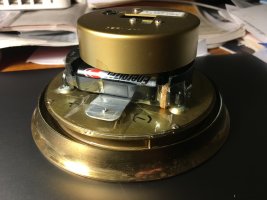My Weems and Plath Quartz Ship's Bell clock began keeping inaccurate time last year. It worked for a month or two, then stopped, or ran slow. These handsome clocks are present on many Ericsons, are easy to read at a distance and so become part of daily routine. I never used the ship's bell function, if it ever worked.
A new one is $750. Theoretically they're guaranteed for life, but when I called Annapolis to inquire about that, it, er, depends. Corrosion of any kind isn't covered. "Just send it in and we'll let you know the cost of repair." Ah, yes. Maybe free, very very maybe not free, shipping both ways to find out, three months wait.
Despite the history of chronometers in the quest for longitude, clock movements today are dead cheap. I recalled buying a kid a Mickey Mouse watch 30 years ago for $6. For our ship's clock job, the cost of a new quartz movement was $15. New hands are $1 more.
I adapted such a movement to the Weems & Plath, which now runs fine again. I gave up the ship's bell feature.
Here are the original works. I have no idea what all that stuff does, most of it probably for the chime function. The circuit board did have corrosion, which was visible only when disassembled. (Disassembly voids any warranty)
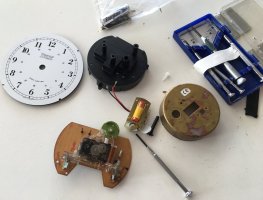 ...
...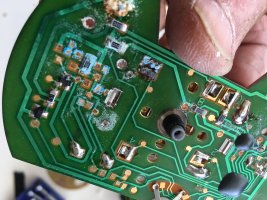
The replacement of the existing movement with the new one is straightforward, but has one sticking point. The Weems and Plath movement is secured to the bezel by a backing plate. The cheap replacement is secured by a ring nut against the face of the clock. Therefore, mounting needs adaptation.
The key to success is choosing the right length of threaded shaft, so the shaft doesn't hit the glass face of the clock. The W&P clock shaft is short, since it needs no ring nut. However, a ring nut requires a fairly long shaft--which then makes the shaft hit the glass. Measuring for threaded shaft length is a critical part of ordering a movement.
The adaptation requires dispensing with the ring nut and positioning the replacement movement back from the face, using some sort of spacer. I made one from a piece of plywood, glued to the back of the face with a glue gun. The attachment needs to be secure, because if the movement wobbles, or the post isn't 90 degrees relative to the face, the hands can touch the face or each other, and stop.
.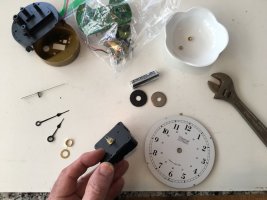 ..
..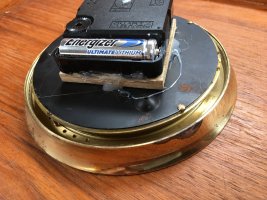
No aptitude is required for this job, although a magnifying glass is. Smallest screws I've ever seen. Nothing much to go wrong, and if you screw it all up--well, total cost of starting over from scratch is very little.
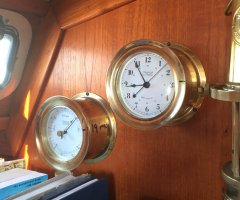
Total cost, $16. Clockworks link. Good idea to order new hands ($1), and a new sweep second hand ($1), in case the W&P hands get damaged or don't fit. There are many YouTube tutorials on "installing a new clock movement."
Warning:
Do not fall into watch repair channels, you'll never get out. Under no circumstances try to understand how a quartz clock works, it is too way cool.
Indexed as a Thelonious blog entry here:
A new one is $750. Theoretically they're guaranteed for life, but when I called Annapolis to inquire about that, it, er, depends. Corrosion of any kind isn't covered. "Just send it in and we'll let you know the cost of repair." Ah, yes. Maybe free, very very maybe not free, shipping both ways to find out, three months wait.
Despite the history of chronometers in the quest for longitude, clock movements today are dead cheap. I recalled buying a kid a Mickey Mouse watch 30 years ago for $6. For our ship's clock job, the cost of a new quartz movement was $15. New hands are $1 more.
I adapted such a movement to the Weems & Plath, which now runs fine again. I gave up the ship's bell feature.
Here are the original works. I have no idea what all that stuff does, most of it probably for the chime function. The circuit board did have corrosion, which was visible only when disassembled. (Disassembly voids any warranty)
 ...
...
The replacement of the existing movement with the new one is straightforward, but has one sticking point. The Weems and Plath movement is secured to the bezel by a backing plate. The cheap replacement is secured by a ring nut against the face of the clock. Therefore, mounting needs adaptation.
The key to success is choosing the right length of threaded shaft, so the shaft doesn't hit the glass face of the clock. The W&P clock shaft is short, since it needs no ring nut. However, a ring nut requires a fairly long shaft--which then makes the shaft hit the glass. Measuring for threaded shaft length is a critical part of ordering a movement.
The adaptation requires dispensing with the ring nut and positioning the replacement movement back from the face, using some sort of spacer. I made one from a piece of plywood, glued to the back of the face with a glue gun. The attachment needs to be secure, because if the movement wobbles, or the post isn't 90 degrees relative to the face, the hands can touch the face or each other, and stop.
.
 ..
..
No aptitude is required for this job, although a magnifying glass is. Smallest screws I've ever seen. Nothing much to go wrong, and if you screw it all up--well, total cost of starting over from scratch is very little.

Total cost, $16. Clockworks link. Good idea to order new hands ($1), and a new sweep second hand ($1), in case the W&P hands get damaged or don't fit. There are many YouTube tutorials on "installing a new clock movement."
Warning:
Do not fall into watch repair channels, you'll never get out. Under no circumstances try to understand how a quartz clock works, it is too way cool.
Indexed as a Thelonious blog entry here:
Last edited:

